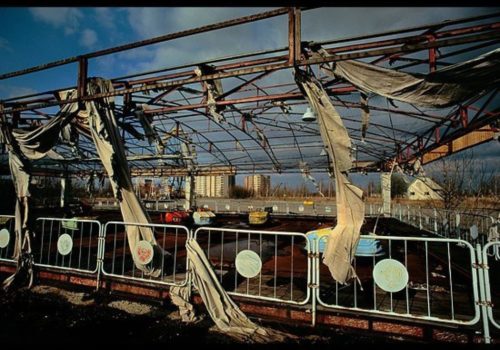At 1:23am on April 26th, 1986, operators in the control room of Chernobyl Nuclear Power Plant botched a routine safety test, resulting in an explosion, and a fire that burned for 10 days. The radioactive fallout spread over tens of thousands of square miles, driving more than a quarter of a million people permanently from their homes. It was the world’s worst nuclear disaster to date.
To commemorate the tragedy 25 years later, I plan to return to the reactor and the areas around it to investigate the current state of contamination to the land; to report on the progress of its cleanup; and to examine the health consequences in the fallout regions. I am asking for your support so that this important story will not be forgotten.
As traditional news outlets struggle financially, photojournalists must now turn to alternative funding methods for long-term projects close to their heart. While many in the media have turned to celebrity reporting, photographers like myself are convinced that there is both the need and the demand for serious content. Therefore, as the 25th anniversary of the Chernobyl disaster approaches, I am asking you and the Kickstarter community for sponsorship to help fund this long-term project.
I want to continue my coverage of the aftermath of the accident; to update it; to expand it in respect to region and content; and to take my cameras again to severely contaminated areas with the understanding that some of my explorations are not without personal risk. Like many of my colleagues, I do this on behalf of the otherwise voiceless victims who expose their own suffering solely in the hope that tragedies like Chernobyl may be prevented in the future.
You can be part of the new wave of citizen-funded journalism for projects traditional media sources are under-reporting. Your donations will contribute to awareness through exhibits, self-publishing, and new-media applications. The first exhibit will open in May 2011 at the Horizonte Photo Festival in Germany where Jürgen Trittin, former Federal Minister for the Environment in Germany, and now Chairman of the German Green Party, has agreed to be the patron for the exhibition, “DER LANGE SCHATTEN VON TSCHERNOBYL/The Long Shadow of Chernobyl” and will help to bring a focus of environmental awareness to the event.
Gerd Ludwig
About the Chernobyl Nuclear Disaster
The Chernobyl Nuclear Power Plant sits inside a fenced area known as the Exclusion Zone. Radioactive remnants of the failed reactor continue to smolder inside the so-called sarcophagus, a concrete and steel encasement hastily erected after the accident. Leaky and structurally unsound, it now threatens to collapse, shaking loose enough radiation to cause a second disaster of similar magnitude. Work has already started on a new encasement, which will slide over the existing sarcophagus to seal in the remaining nuclear fuel. In the mean time desperate efforts are underway to shore up the sarcophagus to protect it from collapsing.
In the 1970’s the town of Pripyat, only 2 miles away from the reactor, was constructed for the plant’s personnel. Its 50,000 inhabitants were evacuated 36 hours after the accident. Today a chilling ghost town, its buildings still bear witness to that hasty departure. While nature is rebounding, the town is unfit for human habitation for hundreds of years to come.
Ignoring radiation levels, hundreds of elderly people have returned to their village homes inside the Exclusion Zone, preferring to die on their own contaminated soil instead of a broken heart in anonymous city suburbs. 70% of the fallout drifted into Belarus contaminating nearly a quarter of that country. Here mobile medical units are still reporting severe thyroid anomalies.
An earlier report by the United Nations estimated that 4,000 people will eventually succumb to cancer-related illnesses as the result of the accident. However, major environmental organizations state that more than 100,000 people have already died as a consequence of the disaster. No matter the official toll, and in light of a worldwide effort to paint nuclear energy as green energy, it is important that we remember the Chernobyl accident as a possible outcome of nuclear power.
About Gerd Ludwig
Born in Alsfeld, Germany, Gerd Ludwig studied with Professor Steinert at the Folkwang University of the Arts in Essen, Germany, graduating in 1972. The following year he co-founded VISUM, Germany’s first photographer-owned agency, and began working for publications such as Geo, Stern, Spiegel, Time, and Life. Soon after moving to New York in the mid 1980s, he started photographing for National Geographic Magazine. His humanistic focus on environmental issues and the socio-economic changes following the dissolution of the Soviet Union resulted in the exhibition and book, Broken Empire: After the Fall of the USSR, a ten-year retrospective published in 2001. His ongoing coverage of post-Soviet Russia has garnered his distinction as being the world’s foremost color photographer documenting the region.
















